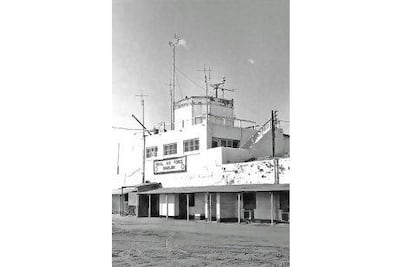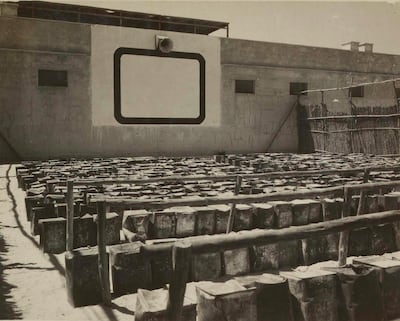It was May 1943 and the world was in the grips of the Second World War. Elsewhere, Allied forces were busy waging the Battle of the Atlantic, which would become a turning point in the campaign at sea against the Germans.
But in Sharjah, a world away from the battle front line, Royal Air Force troops stationed in the UAE were busy organising a legacy of their own.
For May 4, 1943, exactly 77 years ago this Monday, marked the launch of what is believed to be the first cinema in the UAE, located at the RAF Sharjah base and open to soldiers and locals.
Historic black-and-white pictures from the time show a projection screen painted on to the side of a wall of the rest house, the words "Sharjah Paramount" scrawled alongside in white paint. The makeshift open-air theatre was complete with seats made of old petrol tins.
Sharjah was an important military outpost
Sharjah was an outpost for RAF operations in the region since 1942.
RAF Sharjah was key in ensuring peace and stability in the region. The British air base may have been small, but it was vital in resupplying Allied lines and countering Axis submarine activity in the Sea of Oman and Arabian Gulf.
And, according to the operations record books kept by troops stationed there at the time, courtesy of the UK National Archives, they also established the UAE's first cinema.
Under the entry for May 4, 1943, a note proudly states: "Station cinema opened and was large success.”
The cinema was also mentioned in log books from September 1943, which also gives the first indication that it welcomed locals.
There is a log of every film screened for soldiers over the proceeding weeks: on September 1, Russian film Guerrillas and Heroes; on September 3, Harold D Schuster's Ma, He's Making Eyes at Me; on September 6, the 1941 film The Man Who Lost Himself; and on September 10, the 1940 American comedy Slightly Tempted.
Then on September 12, an entry mentions the screening of a weekly movie night open to the wider public.
"The usual weekly film show for the local Arab population was again very well attended."
'The rubbish projected on our screen is an insult'
However, at some point, the opinion of the cinema seems to have somewhat soured.
In the book Imperial Outpost in the Gulf, written by archaeologist Nicholas Stanley Price and published in April 2012, the cinema was said to have come under fire by the medical officer, both for its functional deficiencies and the quality of films being shown.
"The rubbish projected on our screen is an insult to the intelligence of our personnel and from remarks of visiting American aircrews, it is evident that the impression created is an unfortunate one," the medical officer was reported to have said.
As well as being forced to sit on petrol cans, moviegoers had to endure "projector breakdowns, a poor sound system, sand flies and wind-driven sand in the eyes".
"Even so, it was extremely popular," Stanley Price wrote.
1945: the year Bollywood arrived in the UAE?
However, the criticism may have spurred improvements into action. By 1945, the cinema was showing recent western feature films, as well as Indian films imported from Karachi. So, could this have been the moment when Bollywood was first screened in the UAE?
Historian Ali Iqbal has been studying the presence of the RAF in the UAE during the Second World War for years, and came across the cinema in his research.

He says the fact the cinema was open to locals as well as the RAF proves they "had a good working relationship with the Emiratis".
This is further confirmed by a record entry from September 2, which marked the beginning of Ramadan in 1943.
"At the beginning of the feast of Ramadan, all ranks were reminded of the importance of correct behaviour," the record says.
"This relationship was further complimented by their respect for the local religion and culture in that they reminded all ranks to be mindful of the month of Ramadan. So the facts prove they supported each other in various ways," Iqbal says.
The historian points to an incident in February 1943, in which an RAF plane crashed due to engine failure near Al Dhaid, killing three of the five on-board.
Local tribesmen helped the two who survived the crash, further evidence of co-operation between the British and Emiratis.
"So tolerance and co-existence was in existence way back then, as well," Iqbal says.
Over the course of September, screenings continued at RAF Sharjah every couple of nights for the soldiers, and weekly for the locals – "in the evening, the local Arab population attended the cinema in large numbers" an entry for September 19 says.
Other films included Alias the Deacon, a 1940 American comedy film, 1941 Western Badlands of Dakota, 1939 comedy-drama Winter Carnival and Tight Shoes, another comedy from 1941.
The RAF base in Sharjah remained in use until December 1971, when the royal forces formally left and the station became the emirate's international airport.
Almost all of the base survives, even after it was finally closed to make way for the new airport in 1977.
The control tower, hangar and what was the original Imperial Airways guesthouse now comprise Al Mahatta Museum, which tells the story of aviation in the Gulf.




